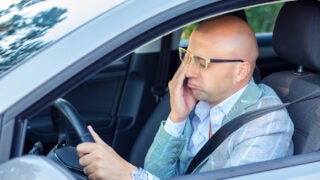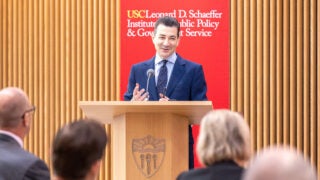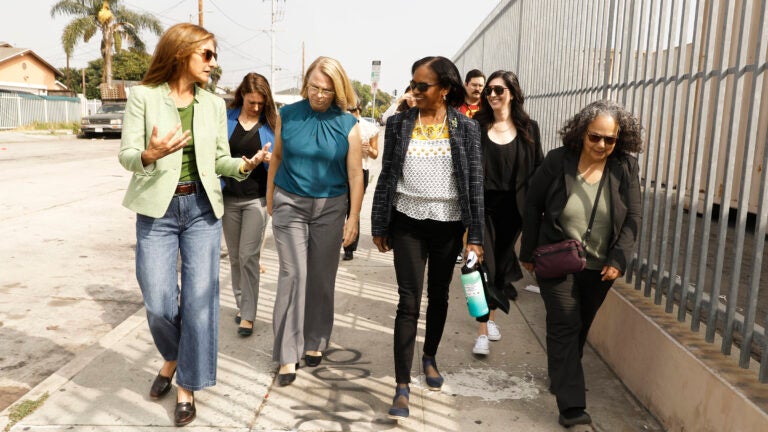
Visiting the neighborhood around Bethune Middle School are, from left: CEO Wendy Butts of the L.A. Conservation Corps, Amanda Amaral and Amy Schulenberg of L.A. Sanitation and Environment, Brenda Mallory of the White House Council on Environmental Quality, Monica Dean of the USC Dornsife Public Exchange and Nancy Sutley, Los Angeles deputy mayor of energy and sustainability. (USC Photo/Steve Cohn)
USC Urban Trees Initiative helps bring shade to local middle school
With assistance from USC and the federal government, the city of L.A. is cooling local neighborhoods one school at a time by planting trees along sidewalks.
On the sun-baked corner of West 67th Street and South Main Street, shade is hard to come by. The nearly 1,000 students enrolled at the adjacent Mary McLeod Bethune Middle School need relief from rising temperatures. Thanks to support from USC’s Urban Trees Initiative, a solution is on the way.
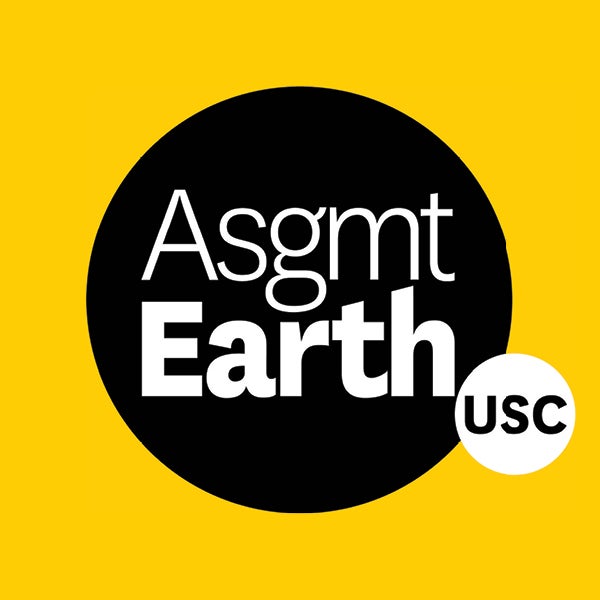
The area will eventually have more than 60 trees lining its streets as part of a $3 million urban greening project made possible with a grant to the city of Los Angeles from the U.S. Forest Service for Urban and Community Forestry. The grant is funded through the Inflation Reduction Act to increase equitable access to trees and nature. USC Trees — a partnership between the city and USC to guide a more equitable urban forest — identified Bethune Middle School as a priority location due to its pollution exposure and lack of shade.
USC Trees is a project of the USC Dornsife College of Letters, Arts and Sciences Public Exchange initiative, which connects academic researchers with policy, industry and nonprofit partners to tackle complex challenges.
Earlier this month, USC Dornsife Public Exchange, the city of L.A. and the L.A. Conservation Corps welcomed Brenda Mallory, chair of the White House Council on Environmental Quality, for a firsthand look at the work being done to combat urban heat, one of the city’s biggest issues, and how various institutions, community groups and levels of government can work together to solve it.
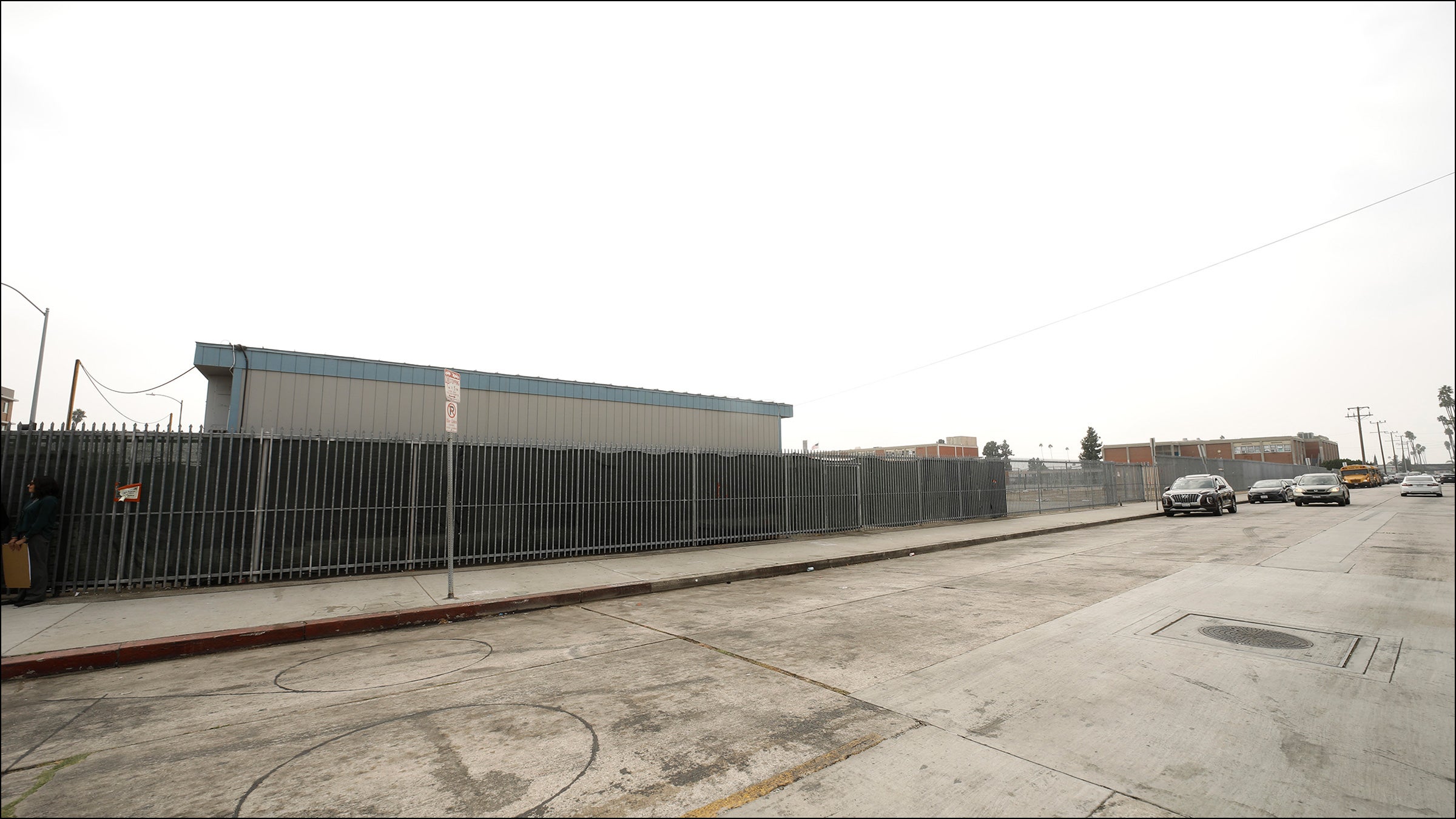
“I think this collaboration shows the value of research universities in dealing with these big social issues,” said Monica Dean, climate and sustainability practice director with the USC Dornsife Public Exchange.
Origins of USC’s Urban Trees Initiative
Dean says the Bethune Middle School project will begin early next year, but the studies that led to this moment were years in the making. USC Trees published its first strategic guide for tree-planting opportunities in 2021, identifying Eastside communities such as Lincoln Heights, El Sereno and Ramona Gardens as high-need areas.
Then, from August 2021 to December 2022, USC Trees began looking into the areas of Boyle Heights, University Park and City Terrace/East L.A. to identify places with the greatest need.
According to USC Trees, in the University Park and South L.A. zone, just over one-fifth of residents are ages 0-14 or 65 and up — two groups who face the highest risk of adverse effects from extreme heat and pollution.
“We’re in a very fortunate position to have faculty who care about the communities that we work in and live in — and who want to work in partnership with the city and nonprofits to help maximize their resources and energy and effort,” Dean said.
A visit from Washington
The visible evidence of the upcoming project is scant: just a few painted markers on the sidewalk that indicate where trees will be planted. But as representatives from the city and USC walked along West 67th Street with Mallory and saw students walking out of the school’s gates, the need for the trees was obvious.
Bethune Middle School lies just east of the 110 Freeway, so the hundreds of thousands of cars passing nearby are clearly visible from where students walk in and out of school. It’s an experience that you can’t get from simply looking at a map, which is why Mallory said visits like this are so important.
“You do get a much better sense of the nature of the challenge and what more may be needed in order to provide additional support,” Mallory said during the visit. “Planting trees is a valuable step, but from a policy perspective, if we’re really serious about expanding access to nature and the availability of nature to all communities, what are some of the other elements besides providing trees that are going to be needed?”
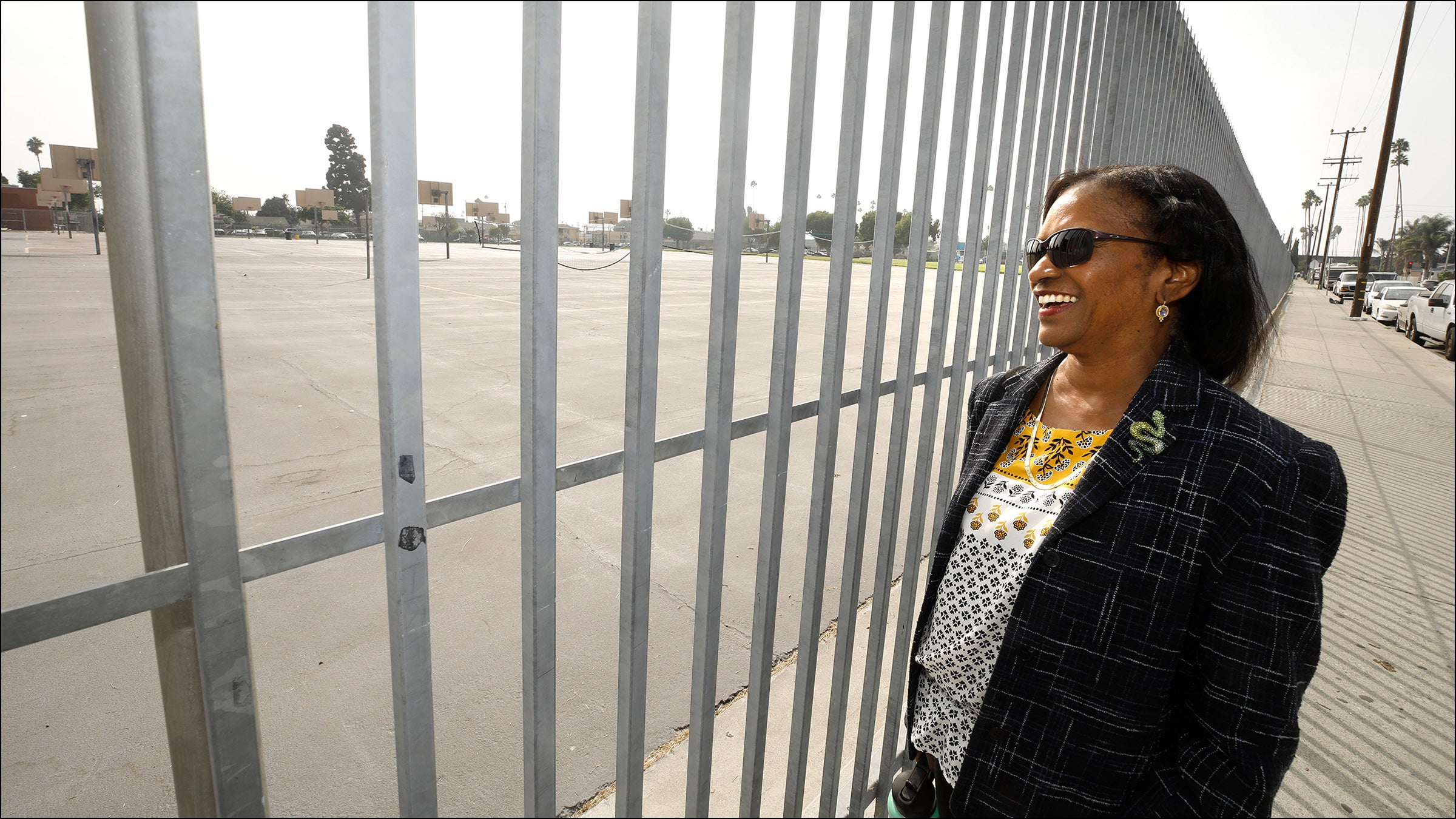
Mallory’s visit to L.A. also included a roundtable discussion at USC Village, where the presidential advisor met with researchers, local government representatives and nonprofit leaders to discuss challenges and current projects addressing urban greening efforts across the city.
USC Urban Trees Initiative: A community partnership
USC Trees is a collaborative effort between the USC Dornsife Public Exchange, the USC Dornsife Spatial Sciences Institute, the USC Dornsife Carbon Census network, the USC School of Architecture’s Landscape Architecture program, USC’s Office of Community and Local Government Partnerships, and the city of L.A.
The site outside Bethune Middle School is just one project of the U.S. Forest Service for Urban and Community Forestry’s grant awarded to the city. The grant will also support the planting of 2,500 street trees along the perimeters of schools and in surrounding neighborhoods, providing improved air quality and multiple health benefits for residents.
According to Amy Schulenberg, tree planting project coordinator for L.A. Sanitation and Environment, the area is emblematic of an “urban heat island” with high traffic and low shade. That’s why planting trees isn’t just for aesthetic purposes.
“If we can lower the ambient temperature in front of our schools and homes, we could save lives out there too,” Schulenberg said.


